How to cook perfect prime rib (closed oven method)
How to cook prime rib that’s juicy, tender and perfectly cooked without a lot of fussing and fretting is easy with a simple closed oven method. Seasoned to perfection, get ready to slice off your own little (or big) bit of beef heaven and celebrate in style.
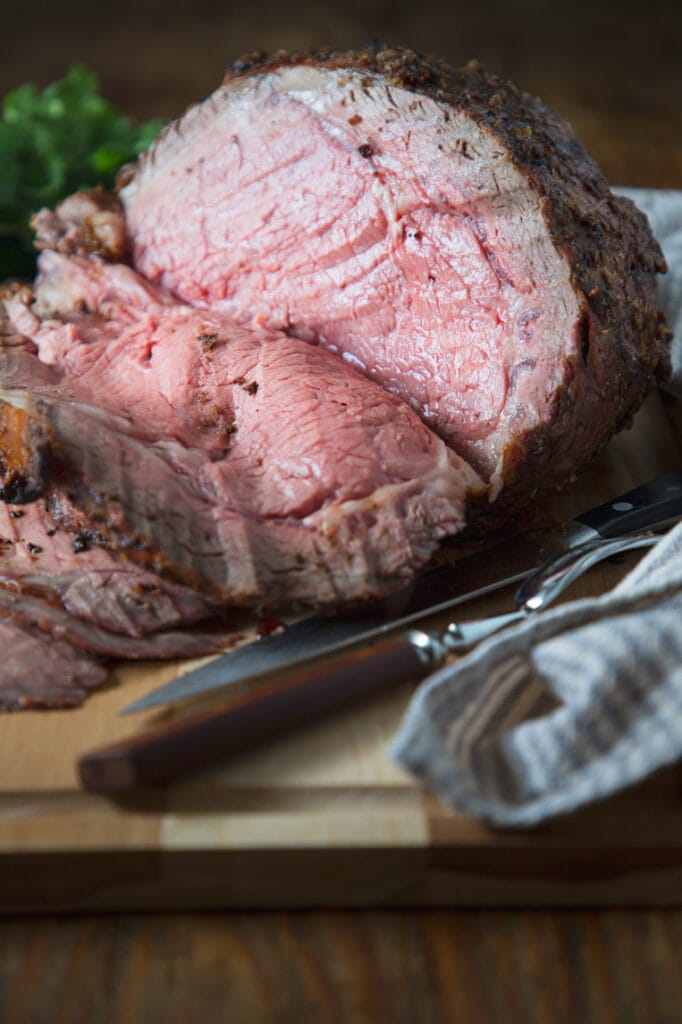
What is a prime rib?
Prime rib is a specific cut of beef that comes from the front section of the backbone of a steer (a bull that’s been castrated) called the rib primal and is primarily for support. Because the muscle doesn’t need to do a lot of work makes it very tender.
You may find prime rib under other names like standing rib roast or holiday roast and it’s the same cut used to make ribeye steaks.
What’s the difference between prime and choice beef?
The word “prime” is addressing the quality and marbling or distribution of fat throughout the lean parts of the beef. For years beef came in three choices: Prime, Choice or Select. Recently the Prime label is being used less and less and has been almost completely replaced by Choice selections at supermarkets.
When you purchase yours, ask your butcher if it is Prime or Choice–it will likely be Choice which has slightly less marbling than Prime but will still be wonderful.
Where do I buy the roast and what do I ask the butcher to do to it?
If you have a good butcher in town, start there. I don’t have any local butcher shops so I went to Kroger where there is an actual butcher. Don’t think for one minute you can stroll up to the guy who unloads sausage in the meat section at Walmart and ask him for a prime rib.
There are no butchers in any Walmart. I know some Sam’s Clubs and maybe even Costco sell them as well.
When you pick it up, make sure you tell the butcher:
- How many ribs you want. (3 ribs serves about 8-10 people)
- To take off the ribs and tie the roast to it. (You can take them off yourself, but it’s easier to let the butcher do it)
- That you’d like the cut with the biggest fat cap on it if possible.
You may not see any prime ribs out on the shelves at the store. If you don’t, just ask. It will probably have to be custom cut from meat they keep in the back. If you find one on the shelf and it has the ribs still in, just take it to the butcher counter and ask them to cut the ribs off and tie it for you.
Tools you absolutely have to have to make this work. Period.
There are only a couple of tools you need to cook a prime rib but they are essential. If you don’t have them, don’t try.
A meat thermometer. The most essential is a (affiliate link) meat thermometer. You need one that has a cable on it that keeps one end on your counter and one end in the meat or a fancy one that connects to your phone would also work. You just can’t be opening the oven to check things so use one that keeps the display where you can see it constantly. Meat thermometers are not expensive and will tell you exactly when your standing rib roast is ready. (affiliate link) This one is affordable, easy to use and does the job.
A roasting pan. You need a pan made for roasting. You won’t need the metal rack they come with (the ribs of the beef serve that purpose) so just set that to the side. Roasting pans are just deep enough to catch the splatters but not so deep that they hold in steam and make your meat soggy on the outside. (affiliate link) I like this affordable one in stainless steel to avoid the chemicals in non-stick pans.
How many people will one prime rib feed?
Portion sizes of prime rib are referred to as the number of “ribs” or “bones”. The thickness of three ribs will feed 8-10 people depending on how many side dishes and extras you have. Most butchers estimate one pound per person–that’s a lot of meat for me but you’ll know your people and how much they eat better than anyone.
I served a three rib, 8-pound roast to my family of 7 and had one pound left over and they were HUGE eaters so that’s pretty close to on par with one pound per person.
What temperature do I cook my beef to?
Beef is it’s most juicy and flavorful between 130 and 135. That’s medium/medium rare. Prime rib should never be cooked to well done. If you have people you’re serving who don’t like pink in their meat, serve them the edge slices. Those will be more well done.
With the closed oven method, my prime rib didn’t increase in temperature once I took it out of the oven but if you use another method you can expect your meat to increase in temperature by up to 10 degrees after you take it out so plan accordingly and remove it a few degrees cooler than you’d like it to be.
Use this guide to determine what temperature you’d like your prime rib to be:

How to prepare prime rib for oven roasting step-by-step
Step 1: Bring your prime rib roast to room temperature. If your roast is cold in the center it will make it hard to roast evenly. Bring your roast out 3-4 hours before you want to cook it and leave it on the counter. I know that feels terrible to do but it’s okay, I promise.
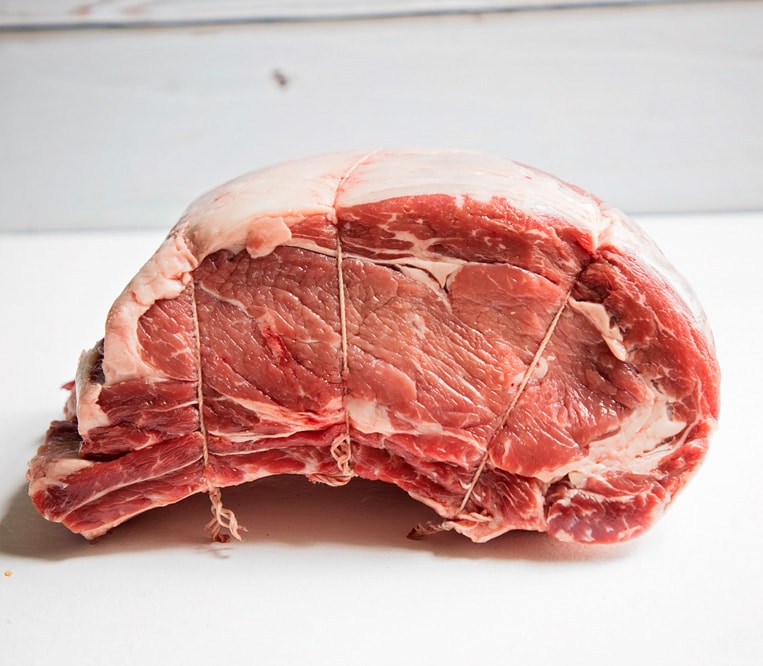
Step 2: Preheat the oven to 500 degrees and prep the meat. Rub the roast all over with butter (a note on this to come) and a blend of Herbs de Provence. This is a spice blend you can find in just about any grocery store or here on Amazon. Then sprinkle with kosher salt until it’s evenly coated on all sides. Don’t be stingy with the salt. I used a couple of tablespoons on an 8 pound roast. Lay the roast (rib side down) into a rimmed roasting pan and insert a meat thermometer into the thickest portion, not touching any bone.
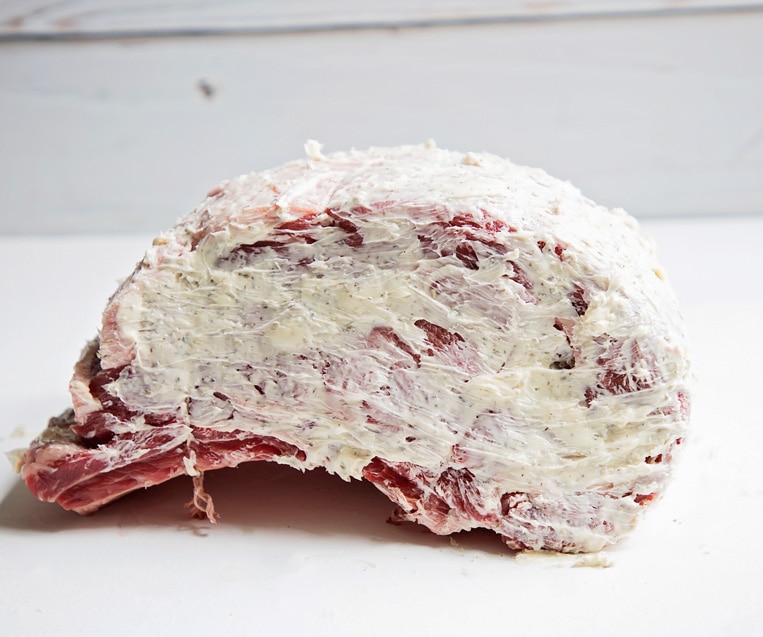
Step 3: Slice 4 russet potatoes in to 1/2″ or thicker pieces and lay them around the meat. You don’t have to eat these (but Lordy they are delicious)–they are only there to catch the butter drips and prevent any fat that drips off from smoking and burning. Try to just get an even layer of potatoes in your baking pan.
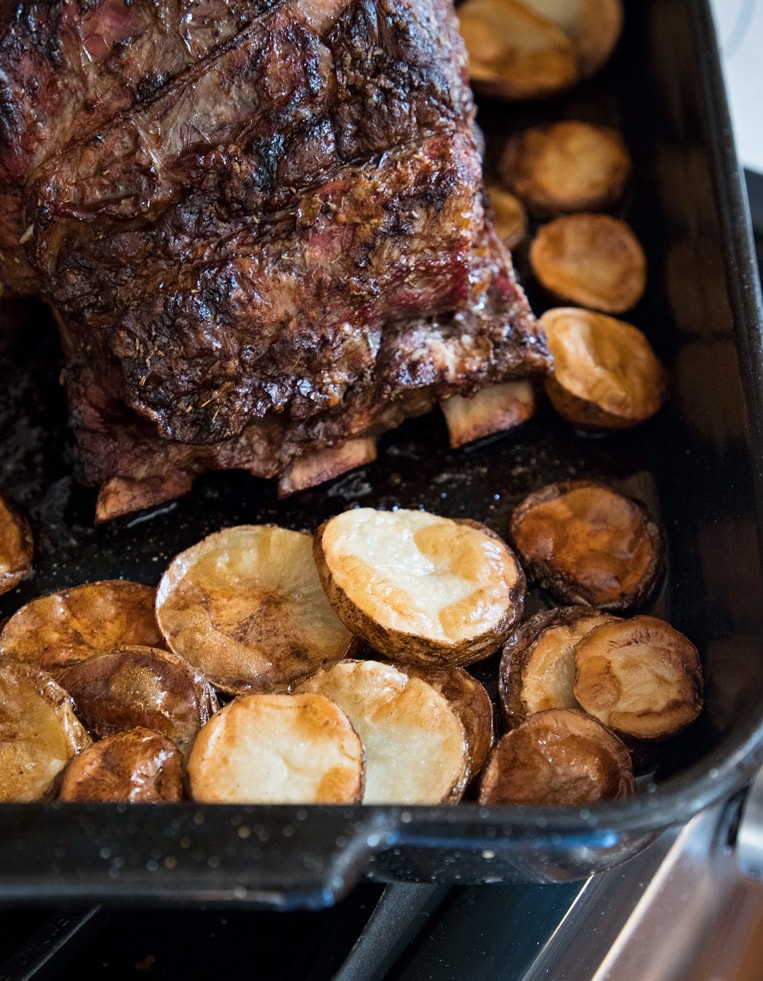
Step 4: Calculate your cook time. You need to estimate 5 minutes per pound. Look at the label that came on your meat to know exactly how much it weighs. Multiply that number times 5 and that’s the number of minutes to cook your roast at 500 degrees. My roast was 7.95 pounds x 5=39.75 minutes or 40 minutes total.
NOTE: If you have a large roast you plan to split into two, as long as you have plenty of space between them for air to circulate, you can treat them as a single roast. Example: A 16 pound roast split into two 8 pound roasts would cook for 40 minutes.
Step 5: Roast and monitor. Cook the prime rib at 500 degrees for your calculated time then turn the oven off and do not open the door. I mean it. Do not open it for anything for 2 hours. During that time, watch your thermometer–you are aiming for a roast that’s about 130 degrees before you take it out of the oven. Read below for steps to take if your oven cools off to quickly.
Step 6: Rest. Once your beef reaches 130 degrees, remove it from the oven, try not to drool all over yourself and let it rest uncovered until the internal temperature is 120 degrees. Just leave your meat thermometer in it and wait. This step took an entire hour for me so make sure you plan for it. You don’t want those precious juices rolling out all over your counter.
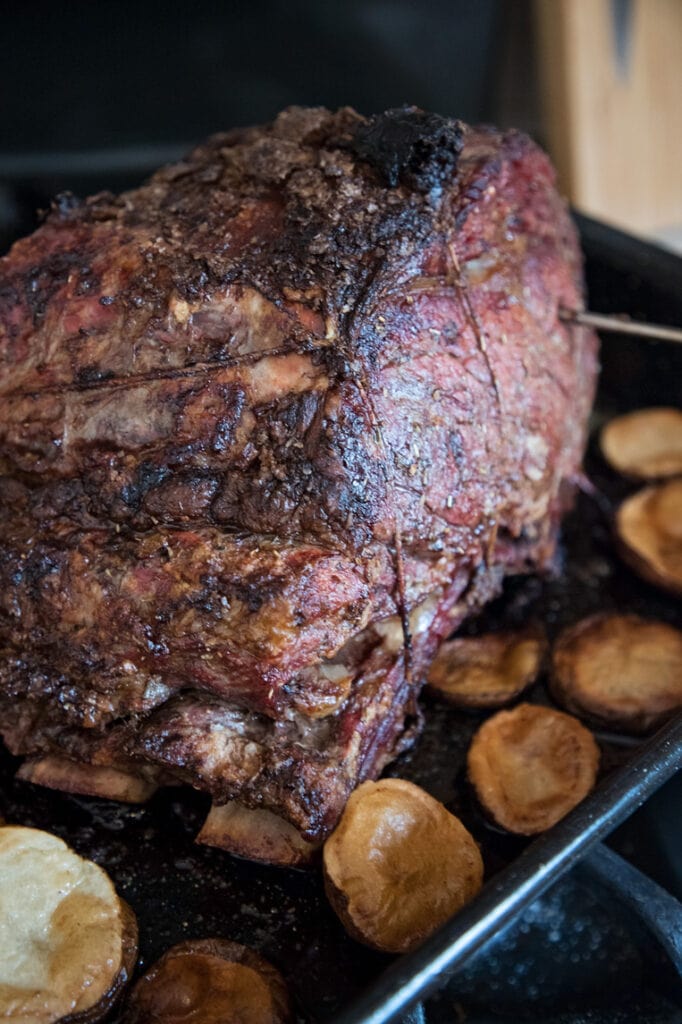
What to do if your oven cools off too quickly and your meat stops cooking
The closed door method for cooking prime rib is supposed to be simple and it is for the most part. But today’s ovens create some challenges with this method (which was created ages ago when ovens were solid) because most just don’t hold heat like they used to and some come with fans in them that automatically kick on to cool an oven down after use. If you have an oven with an automatic fan, this method may not work for you.
When cooking mine, I wanted my meat to get to 130 degrees. After one hour with the oven off it reached 125 and I was worried it would overcook. But it sat there. And sat there. After 20 minutes the temperature hadn’t budged. You should see the temperature on the meat going up a degree or two every 10 minutes or so and mine had stalled. If yours stalls or starts to drop at all, take action.
To fix this problem:
- Keep the door closed but turn the oven to 270 degrees. When mine kicked on to preheat, sure enough the temp was 125 inside. Way too cool.
- Allow the oven to preheat to 270 and leave it on at that temperature for 5 minutes, then turn the oven off again. It may take 5 or 10 minutes for the heat to begin to penetrate but watch your meat thermometer and don’t sweat it.
- When your prime rib gets to 130, just take it out even if the 2 hours aren’t up yet. Mine came out 15 minutes early and was still perfect.
If your meat was really cold when you put it in the oven initially, you may have to do this process a couple of times or leave your oven on 270 for 10 to 15 minutes to really help the prime rib get going. Remember: you won’t ruin it as long as you don’t overcook it. You have a meat thermometer to help you with that, so you’ll do fine!
What to serve with prime rib
Above all, you must have horseradish sauce. I make mine from just good mayonnaise and prepared horseradish but you can also buy it pre-made. Don’t you dare put A-1 on something this delicious. (My daughter does but we won’t talk about that.)
Next, you’ll want to balance the richness of the meat with some lighter items. Try reading up on 25 of my favorite side dishes for beef tenderloin. You’d also like:
- Pear and Gorgonzola Salad
- Sautéed green beans with mustard and shallots
- White cheddar popovers
- Browned butter brussel sprouts
Plan the perfect meal with these side dishes
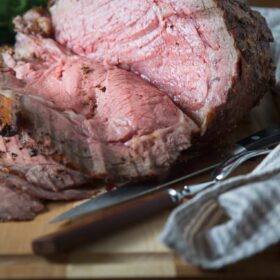
How to cook perfect prime rib (closed oven method)
Equipment
- Oven thermometer with attached probe
Ingredients
- 1 8 pound standing rib roast (prime rib) *See Note 1
- 1/2 cup butter softened, *See Note 2
- 2 tablespoons herbs de provence
- 2 tablespoons kosher salt
- 3 large russet baking potatoes
Instructions
- Remove the prime rib from the refrigerator 3 to 4 hours before cooking so that it can come to room temperature.
- When ready to roast, preheat the oven to 500 degrees and move your oven rack to the lower third.
- In a bowl, mix the butter and herbs de provence. Cover all surfaces of the meat.
- Generously coat the surface of the meat in kosher salt.
- Place the roast ribs down into a roasting pan and insert a meat thermometer into the center of thickest section, not touching the rib bones on the bottom.
- Wash the potatoes and slice them in to 1/2" slices. Lay them in an even layer around the prime rib to catch drips and prevent the butter from smoking and burning.
- Roast your prime rib at 5 minutes per pound. (For an 8 pound roast that's 40 minutes). Then turn the oven off and leave the door closed for two hours.
- Monitor the temperature of the meat. If the temperature fails to climb for 15 minutes or begins to fall, turn the oven back on 270 degrees for 5 minutes then turn it off again. Wait 10 minutes for the heat to reach the center of your prime rib. Continue to monitor your meat and make sure the temperature slowly climbs a degree or two every 5 to 10 minutes. If it doesn't turn the oven back on in bursts until you reach your desired degree of doneness. In this case that was 130 degrees.
- Remove the prime rib from the oven and leave the meat thermometer inside. Allow the roast to cool to around 120 degrees before slicing, but it's fine to slice it sooner if needed. That process can take up to an hour depending on how large it is.
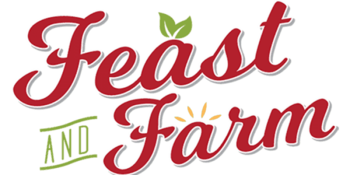
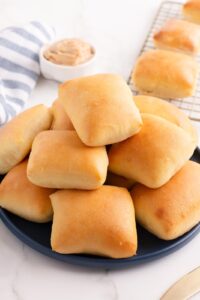
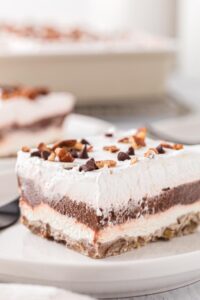
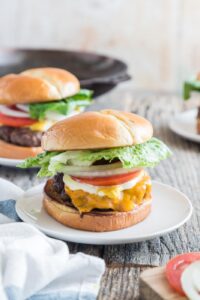
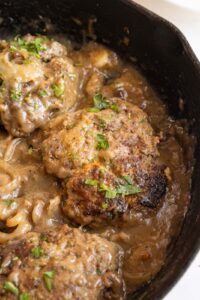
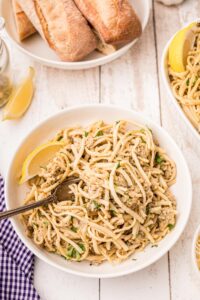
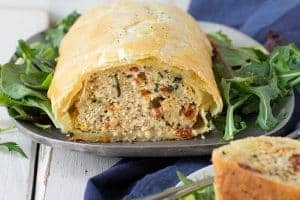
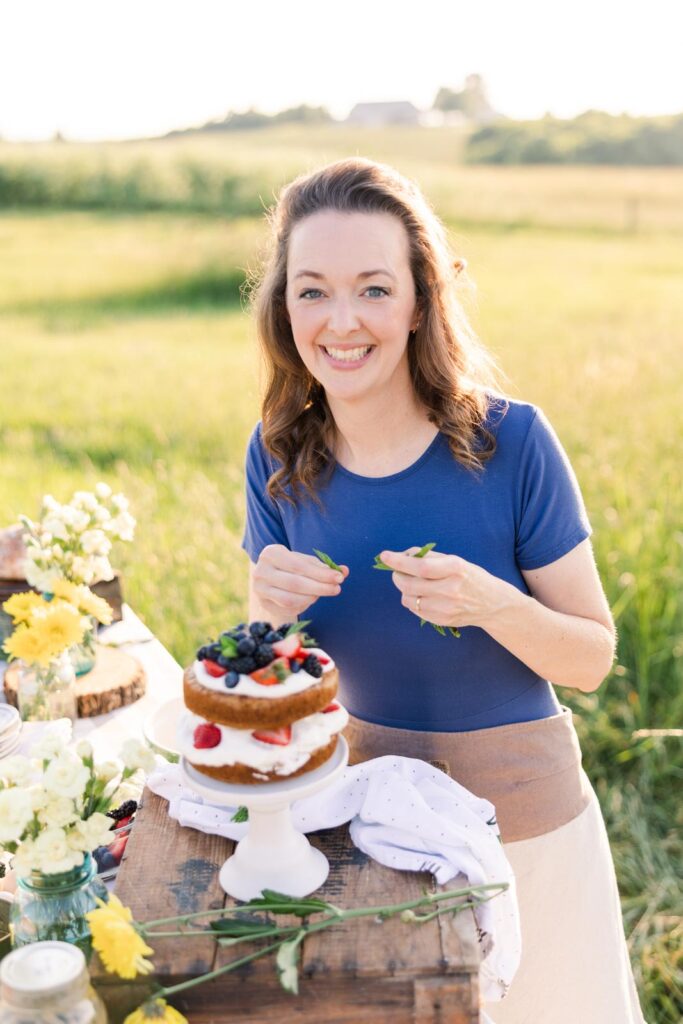
Came out perfect I will only let mine rest for about 20min my husband likes his meat hot, cooled off too soon, but the method is perfection!!!!!
Came out perfectly and it made our Christmas dinner! Thanks SO MUCH for all the details. I was nervous about ruining an expensive piece of meat. My first time and now a new tradition!
I always was too. I felt like in this case the details are very necessary!
Some people should not post online as it simply shows their stupidity. This poster reveals why she must turn the oven back on to 270 right after s/he describes how to reheat at 270. She says “if your meat is cold…” – Ok, do you not know your meat is supposed to be room temperature BEFORE putting in the oven. If you do it right, you do not need to pierce your meat with a thermometer and you do not need to restart the oven.
You know David, if there’s one thing I believe it’s that hurting people hurt people and I will not fire back at you for the sake of continuing that theme here. However I will let you know that I am a SHE–not a he–and that my primary goal with this blog is to help my readers be successful in their own home kitchens.
I’m really glad that you’re a Jedi, and can put your forehead to your oven and automatically know the internal temperature of an 8 to 20 pound hunk of beef. A talent that I do not possess, nor do any of my other readers. By cold I meant that their meat was not up to temperature yet. Good gracious man. I plainly discussed bringing it to room temp up in the information. Bet you didn’t read that either.
You also seem to skip over the fact that modern day ovens have cooling fans and vents that need work arounds. If you had read the post or bothered to find out who you were speaking to, you would have seen that my goal was to help my readers should they encounter a problem with the temperature of their meat.
Success, not hate and insults are what we aim for here. –Rachel
Excellent recipe. Works every time regardless of the weight of your rib roast. I did a 9.05 pound roast and it came out a perfect medium rare based on the calculations provided.
I will add a few things that you might be wondering and hopefully it will answer a few questions…
1. Separating the ribs and tying them back on does a few things for you. It makes carving it easier when done.
2. Tying the roast helps plump the meat up in order to make it a more uniform size. Sometimes you will see the roast is smaller on one end vs the other… tying the meat with butchers twine will make the circumference of the roast similar all the way across it and it will cook more evenly.
3. Coarse Kosher Salt is a little easier to monitor how much you are using because you can see it on top of the butter. Fine salt or table salt will blend right in with the butter and you can have a crust that is too salty to enjoy.
I’m making a 16.3 lb prime rib roast. Do I need to cut the meat in half?
Anna some readers say they do very large 20-25 pound ones with this method and do fine. I’ve never tried it–just plan for much longer cook times. Several hours extra if you keep it whole. –Rachel
@Anna,
No need to cut in half! Actually, cutting it in half will mess up your cooking time calculations!! You will have a cook time based on 8.15 pounds instead of 16.3 pounds!
8.15 x 5 minutes = 41 minutes at 500 degrees
16.3 x 5 minutes = 82 minutes
If you cut it in half and cook the halves for 82 minutes then the 2 halves will be WAY overdone.
Leave it whole if it will fit in your oven
Watch for your butter to smoke like the dickens Anna and if you use the potatoes they will be burned to a crisp. Yes, of course you would need to recalculate the cook time if you cut it in half but I for one don’t have 8 to 10 hours to babysit a huge one. I’d rather do two smalls. –Rachel
My family prefers meat hot when serving. If you rest it uncovered how does it stay at a serving temp or how do you resolve that?
Meat needs a rest time for the juices to redistribute. You’re waiting for the center to come down to 120 for serving which will still feel warm. As soon as I get to 120, I slice it! –Rachel
@Lisa, While the roast is resting, I make an au jus using the beef drippings. When you pour hot jus on your sliced meat, it warms it up. It also tastes fabulous!
Hi. My beast is a whopping 24 lbs.. but the calculations mean on 500 degrees for two hours. Don’t want to burn the beast. But do you think it will be fine?? Thanks
I really hope you’re kidding Leah. Did you see the part in the post where I said not to attempt this recipe with anything larger than an 8 pound roast? I tried a 10 1/2 pound one last week and it was a really miserable experience. If you have that much meat, I would cut that into three separate roasts and cook them in separate pans. 24 pounds would be a nightmare and epic fail. –Rachel
@Leah, I have done several 18-21 LBS roasts and they all turned out perfect. Yes, I was skepticable of cooking a roast that size at 500 for 100 minutes, but it came out great. Put it on the bottom rack. DO NOT open that oven for 2 hours My roasts have always been with the rib in and cut and tied by the butcher. The family requests this every Christmas. Good Luck and ENJOY!!!
Great to know Troy!!
@Leah, I cook a 20lbs prime rib every year with this method. I have never put potatoes it it, but I’m going to try them this year. It always turns out amazing. Just watch the thermometer.
If I add pepper to the seasonings, will this burn like the garlic in a previous comment?
It might, yes. I am a firm believer that just because there’s salt does not mean there needs to be pepper in a recipe. Best to make it as written. –Rachel
Hello I have never made prime rib before. I was wondering in all the steps I never read if you should wash the meat. It maybe a no brainer for some but I was wondering do you wash and pat dry meat or do you just air dry it during time it comes to room temperature? I really don’t wanna mess up a 45$ meat. Thanks Jean
Hi Jean,
Nope, no need to wash the meat. In fact, the practice of washing meat has become a little bit outdated lately. Health experts recommend that we no longer wash chicken especially because that splashes contaminated germs all over the countertops and sink. In the case of beef, there’s no reason to wash cuts because beef don’t carry the same contaminants that poultry does. There certainly is a risk for e-coli in ground beef, but not in large cuts like a prime rib. Simply pat dry with some paper towels and move forward with the recipe. –Rachel
Will the potatoes prevent me from being able to make Au Jus?
Probably. Every time I make this, there really aren’t any drippings at all in the bottom of the pan. That said, if you leave the potatoes out the butter is going to burn and probably set your oven on fire. The smoke point for butter is significantly lower than the 500 degrees that we’re using in this recipe.